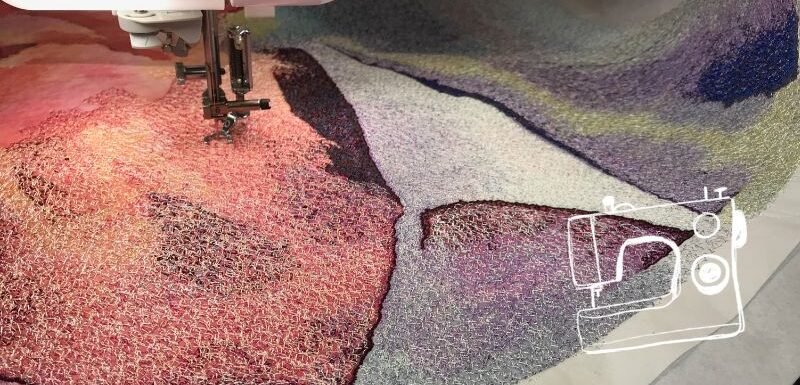Small is mighty! I’m often asked if free motion stitching on a domestic sewing machine is possible. And the answer is a most definitive Yes! If you’ve ever watched demonstrations of free motion stitching and thread sketching at quilt shows, one thing stands out (to me, anyway). They’re nearly all working on large machines.
The thing is, you see, that these talented ladies (and gentlemen) are not only demonstrating their stitching talent, but are often also promoting a particular machine or brand.
So my task today is to set your mind at rest that you can, indeed, create even very large thread sketched and thread painted projects on a standard, domestic sewing machine.
Disclosure: Some of the links below are affiliate links, which means I may receive a small commission (at no further expense to you) if you click through and make a purchase. As an Amazon Associate I earn from qualifying purchases from Amazon websites.
Free motion stitching on a domestic sewing machine
What type of sewing machine do I need?
I worked for years (many years) on a regular machine and even now only have a slightly larger machine. There is no reason why intricate thread paintings and even large works of art can’t be worked on a standard machine.
A domestic sewing machine typically has a 6″ throat. The only time this may ever make life challenging is when working on a large quilt or thread painting that you need to roll up inside the machine’s throat. Nevertheless, there is usually a way to work with this minor issue.
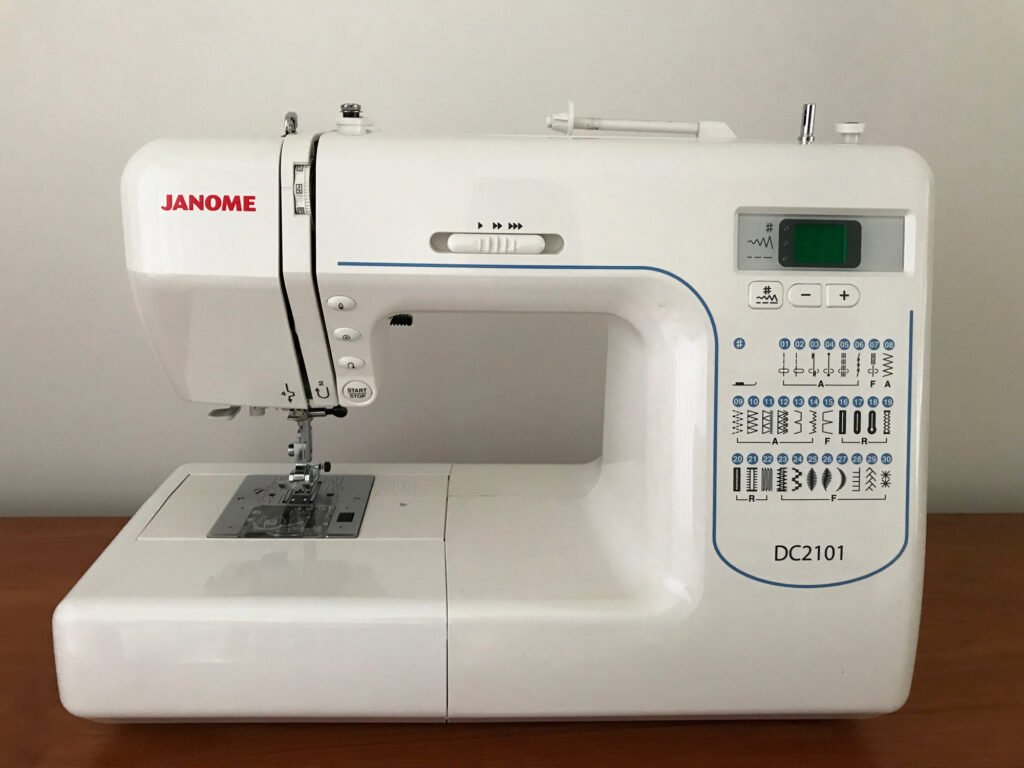

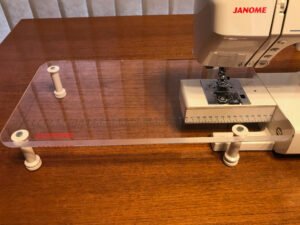
What to look for in a domestic sewing machine:
- A machine that has the ‘drop feed dogs’ function.
- Is able to have a free motion foot attached.
- A machine that will work ordinary straight stitch and zigzag stitch. Most machines include these two stitches as standard settings.
What are Feed Dogs?
The Feed Dogs are the little metal teeth located below the stitching plate, underneath the needle. Their purpose (in normal sewing) is to ‘grip’ and move the fabric along with each stitch taken.
Have you ever noticed how, when doing ‘normal’ sewing, the fabric will move along by itself as you stitch? Lowering the feed dogs switches off this function and the fabric goes nowhere — unless you move it!
Which leads me to the point that, when free motion stitching, the direction of your stitching (back, forward, sideways) is entirely in your hands. Isn’t that exciting? Think of the possibilities!
When ‘free motion’ stitching, you don’t want the feed dogs to rise up to grip the fabric. Having the ability to freely move the fabric in any direction under the needle is what makes free motion stitching so liberating! It can take a little getting used to, but once you are in control, there should be nothing you can’t do!
Dropping the feed dogs — most machines come with a manual switch, or electronic touch button that will lower the feed dogs so that they sit just below the stitching plate under your needle.
While it’s certainly possible to do free motion stitching without lowering the feed dogs, in general, lowering them makes free motion stitching easier.

What is a Free Motion Foot? Which foot is best for stitching on a domestic sewing machine?
A free motion foot is simply another foot attachment to use on your machine. Some machines come with them as a standard supply, but many do not. However, they are generally easy, and inexpensive, to purchase.
They may be called any of these names:
- Darning foot
- Free motion foot
- Open toe ‘hopping’ foot
- Hopping foot
- Closed toe foot.
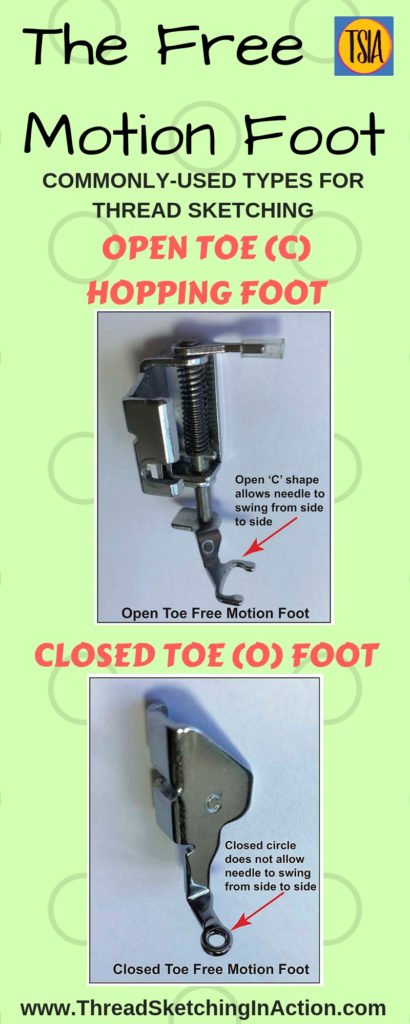
Fitting a free motion foot to your machine
The open toe (C-shaped) hopping foot is your new BFF when doing creative, free motion stitching. Why?
- An open toe foot is the easiest to use as it allows a clear view your work while you stitch.
- It also makes switching between free motion straight stitch and free motion zigzag stitch simple.
The foot is attached to your machine just as you would any other foot. To find out how to fit a new foot to your machine, refer to the instruction manual provided with your sewing machine.
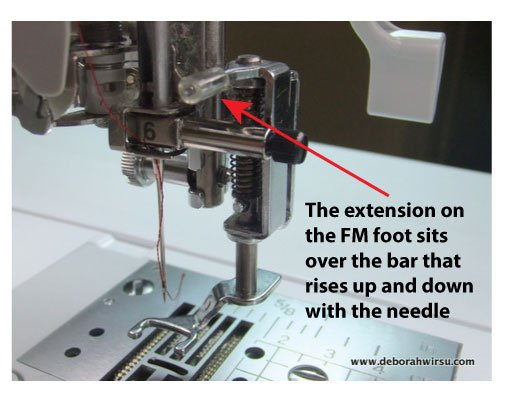
When fitted, a standard ‘hopping’ free motion foot sits with its extension bar over the top of the needle clamp screw.
TOP TIP! Fit an open toe hopping foot to your machine.
Which needle and thread should I use?
Choosing the right needle for the job can make a huge difference to your thread sketching results. There are many different types of needles available, so it’s important to choose one that’s going to best suit your needs. The right needle results in beautiful, trouble-free stitching!
For most thread sketching and thread painting I recommend using an Embroidery needle. Embroidery needles are, as the name suggests, manufactured specifically for doing machine embroidery. As a result, they are less prone to snagging or fraying the thread, and are very sharp.
If you don’t have (or can’t get) an Embroidery needle, try a quilting or top-stitching needle instead.
Needle size
For most projects, needles in the range of 75/11 – 90/14 are appropriate. I generally use a 75/11 or 80/12 Embroidery needle for most of my thread painting.
TOP TIP! Never work with a dull, nicked, or bent needle.
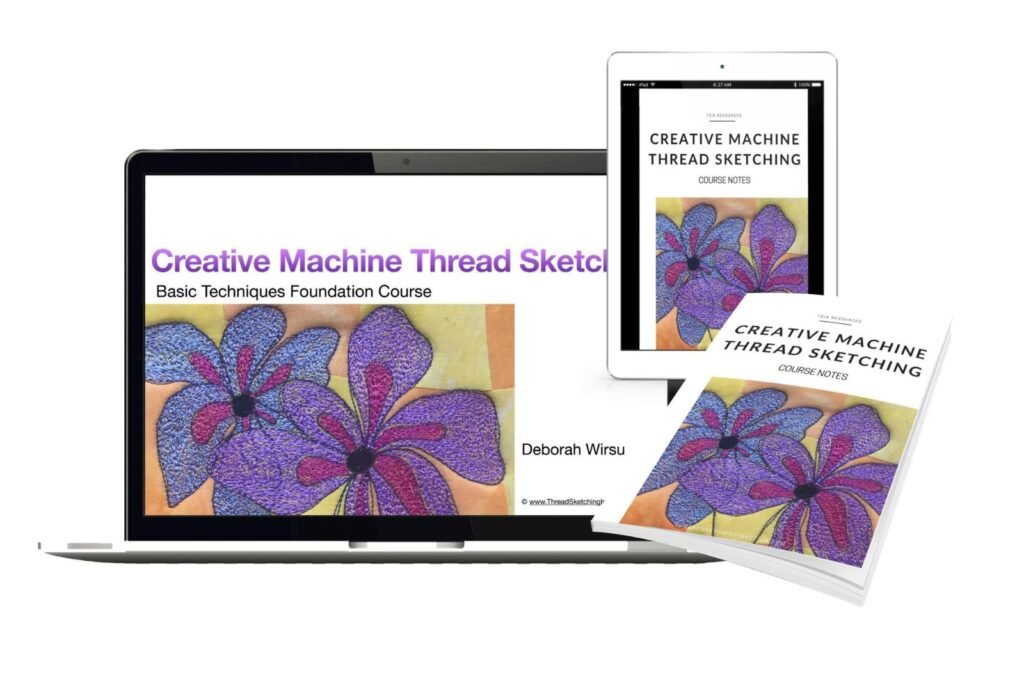
Want to know more? Expert help is here!
If you’re done with trying to teach yourself how to do thread sketching and thread painting, your knight in shining armour has arrived!
This course teaches you everything you need to know, right from the start.
So stop struggling — enrol today!
Which thread?
The range of sewing machine threads available is vast. While it’s certainly possible to use any kind of thread you like for thread sketching and thread painting, I recommend beginning with 40-gauge machine embroidery thread (rayon or polyester).
I make nearly all my designs using 40-gauge thread. The brand doesn’t matter. However, keep in mind that it’s always better to buy quality thread.
Read more about choosing thread – Best Machine Embroidery Thread for Free Motion Stitching.
TOP TIP! Use 40-gauge machine embroidery thread (especially if you’re a beginner).
Video demonstration: Free motion stitching on a domestic sewing machine
Related posts
- How to set up your machine for free motion stitching
- Best machine embroidery thread for free motion stitching
- Best Quilting Machines for Beginners: A comprehensive guide
- Best Sewing Machines for Quilting in 2023
- How to care for your sewing machine: A guide to long-lasting performance
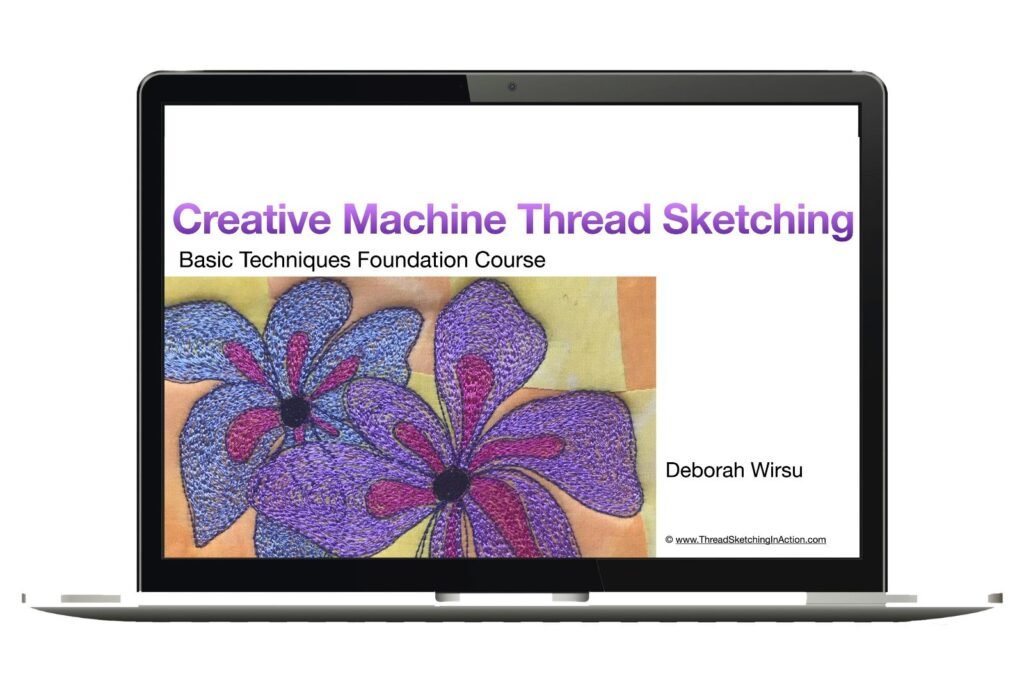
A word from one of my students…
“Hi! I just wanted to say hello and thank you! I have never taken an art, sewing, or quilt class. Having beencompletely self-taught has been fun BUT I am thrilled to have found you! Your style, manner, and expertise are perfect for me to learn new skills and enhance others! I am having so much fun learning from you!”
